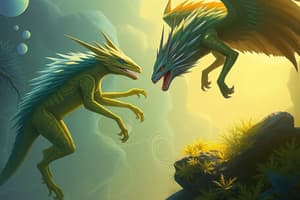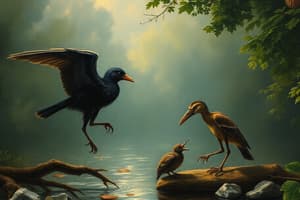Podcast
Questions and Answers
What is the primary benefit the barnacles receive from their relationship with the whale?
What is the primary benefit the barnacles receive from their relationship with the whale?
- Nutrients from the whale's skin
- Protection from predators
- Access to food and a secure living space (correct)
- Assistance in movement through water
What defines a parasitic relationship?
What defines a parasitic relationship?
- One species benefits while the other is harmed (correct)
- Neither species gains any benefit
- Both species are harmed
- Both species benefit equally
Which of the following is true about most parasites?
Which of the following is true about most parasites?
- They always kill their host
- They can only be found inside their hosts
- They may live on or inside their hosts (correct)
- They do not reproduce within the host
How do roundworms typically infect their hosts?
How do roundworms typically infect their hosts?
What is the method by which Tristerix aphyllus, the cactus mistletoe, obtains nourishment?
What is the method by which Tristerix aphyllus, the cactus mistletoe, obtains nourishment?
How does a predator-prey relationship affect the populations of both species?
How does a predator-prey relationship affect the populations of both species?
What role do keystone species play in their ecosystems?
What role do keystone species play in their ecosystems?
In predation, what is the primary role of the predator?
In predation, what is the primary role of the predator?
What typically occurs to the predator population when the prey population decreases?
What typically occurs to the predator population when the prey population decreases?
Which of the following best describes a limiting factor in an ecosystem?
Which of the following best describes a limiting factor in an ecosystem?
How do predator-prey dynamics generally affect energy transfer in food webs?
How do predator-prey dynamics generally affect energy transfer in food webs?
What is one way that all biomes share a common interaction among species?
What is one way that all biomes share a common interaction among species?
What effect would the removal of sea stars from a coral reef community most likely have on the population of mussels?
What effect would the removal of sea stars from a coral reef community most likely have on the population of mussels?
How do camouflage adaptations function for prey species?
How do camouflage adaptations function for prey species?
What is a characteristic feature of intraspecific competition?
What is a characteristic feature of intraspecific competition?
What is one potential outcome of interspecific competition according to the content provided?
What is one potential outcome of interspecific competition according to the content provided?
In mutualism, what benefit do both species receive from their relationship?
In mutualism, what benefit do both species receive from their relationship?
Which of the following is a defining characteristic of commensalism?
Which of the following is a defining characteristic of commensalism?
What is the importance of predator-prey relationships in an ecosystem?
What is the importance of predator-prey relationships in an ecosystem?
Which adaptation is common among both predators and prey?
Which adaptation is common among both predators and prey?
What type of competition occurs between individuals of different species?
What type of competition occurs between individuals of different species?
What role does specialization play in species interactions?
What role does specialization play in species interactions?
Predation refers to a relationship where both species involve members consuming each other.
Predation refers to a relationship where both species involve members consuming each other.
The zebra serves as a predator by consuming grass, even though it does not kill it.
The zebra serves as a predator by consuming grass, even though it does not kill it.
A keystone species is one that plays a minor role in its ecosystem.
A keystone species is one that plays a minor role in its ecosystem.
The prey population generally increases when the predator population goes down.
The prey population generally increases when the predator population goes down.
Limiting factors can prevent the growth of populations within an ecosystem.
Limiting factors can prevent the growth of populations within an ecosystem.
Interspecific competition usually results in both species benefiting equally.
Interspecific competition usually results in both species benefiting equally.
Mutualism is a type of symbiotic relationship where both species involved benefit.
Mutualism is a type of symbiotic relationship where both species involved benefit.
Camouflage is an adaptation used solely by prey to avoid predators.
Camouflage is an adaptation used solely by prey to avoid predators.
Removal of a keystone species like the sea star would result in explosive growth of populations without natural predators.
Removal of a keystone species like the sea star would result in explosive growth of populations without natural predators.
Commensalism is a relationship where one species benefits and the other is negatively affected.
Commensalism is a relationship where one species benefits and the other is negatively affected.
Flashcards are hidden until you start studying
Study Notes
Interaction Among Species
- Predation involves one species (predator) consuming another (prey), establishing a crucial ecological relationship.
- Example of predation: Lions (predators) feed on zebras (prey), while zebras also consume grasses, highlighting a broader definition of predation.
- Predator-prey dynamics contribute significantly to energy transfer in ecosystems, influencing food chains and webs.
Population Dynamics
- Predator-prey relationships help maintain population balance; as prey populations rise, predator populations eventually follow due to increased resources.
- When prey populations decline, predator populations also decrease, illustrating the concept of limiting factors in ecological interactions.
Keystone Species
- Keystone species play essential roles in their communities; changes in their populations significantly impact others.
- Sea stars are identified as keystone species in coral reefs; their removal can lead to an explosion in populations of mussels and sea urchins, threatening overall community stability.
Adaptations to Predation
- Both predators and prey exhibit adaptations for survival, including camouflage, which aids prey in avoiding detection and predators in ambushing their targets.
- Examples include crabs blending with sand, praying mantises mimicking dead leaves, and zebras' stripes confusing predators.
Competition
- Competition is defined as the struggle between organisms for the same resources (food, water, space).
- Intraspecific competition occurs within a species, while interspecific competition occurs between different species.
- Competition can lead to extinction for less adapted species or result in greater specialization, showcasing evolutionary adaptations.
Symbiotic Relationships
- Symbiosis encompasses close relationships between species that may be beneficial, harmful, or neutral.
- Three types of symbiosis include:
- Mutualism: Both species benefit; e.g., goby fish and shrimp that provide mutual protection.
- Commensalism: One species benefits with no impact on the other; e.g., barnacles attaching to a whale.
- Parasitism: One species benefits at the expense of another; e.g., roundworms infecting mammals.
Coevolution
- Coevolution occurs in mutualistic relationships, driving evolutionary changes that enhance interactions, such as specific plants evolving traits to attract pollinators.
Parasitic Plants
- Tristerix aphyllus, or "cactus mistletoe," is an example of a parasitic plant that derives nutrients and water from host cacti, showcasing the complexity of plant relationships in ecosystems.
Interaction Among Species
- Predation involves one species (predator) consuming another (prey), establishing a crucial ecological relationship.
- Example of predation: Lions (predators) feed on zebras (prey), while zebras also consume grasses, highlighting a broader definition of predation.
- Predator-prey dynamics contribute significantly to energy transfer in ecosystems, influencing food chains and webs.
Population Dynamics
- Predator-prey relationships help maintain population balance; as prey populations rise, predator populations eventually follow due to increased resources.
- When prey populations decline, predator populations also decrease, illustrating the concept of limiting factors in ecological interactions.
Keystone Species
- Keystone species play essential roles in their communities; changes in their populations significantly impact others.
- Sea stars are identified as keystone species in coral reefs; their removal can lead to an explosion in populations of mussels and sea urchins, threatening overall community stability.
Adaptations to Predation
- Both predators and prey exhibit adaptations for survival, including camouflage, which aids prey in avoiding detection and predators in ambushing their targets.
- Examples include crabs blending with sand, praying mantises mimicking dead leaves, and zebras' stripes confusing predators.
Competition
- Competition is defined as the struggle between organisms for the same resources (food, water, space).
- Intraspecific competition occurs within a species, while interspecific competition occurs between different species.
- Competition can lead to extinction for less adapted species or result in greater specialization, showcasing evolutionary adaptations.
Symbiotic Relationships
- Symbiosis encompasses close relationships between species that may be beneficial, harmful, or neutral.
- Three types of symbiosis include:
- Mutualism: Both species benefit; e.g., goby fish and shrimp that provide mutual protection.
- Commensalism: One species benefits with no impact on the other; e.g., barnacles attaching to a whale.
- Parasitism: One species benefits at the expense of another; e.g., roundworms infecting mammals.
Coevolution
- Coevolution occurs in mutualistic relationships, driving evolutionary changes that enhance interactions, such as specific plants evolving traits to attract pollinators.
Parasitic Plants
- Tristerix aphyllus, or "cactus mistletoe," is an example of a parasitic plant that derives nutrients and water from host cacti, showcasing the complexity of plant relationships in ecosystems.
Studying That Suits You
Use AI to generate personalized quizzes and flashcards to suit your learning preferences.




